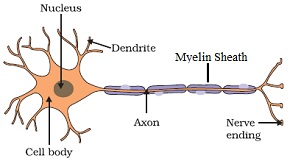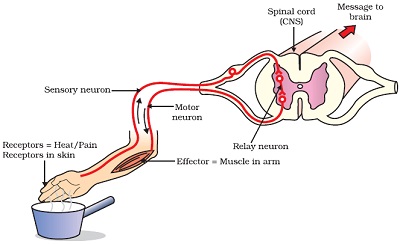Control And Coordination - Class 10th Science
Movement in Response to Environment
Living organisms move in the response to change in the environment. Living organisms move to get advantage of the change. Getting advantage of change in environment is necessary for organisms to survive.
Movement in the response to change in environment is called stimuli.
Examples
A cat may jump or start running after seeing a mouse to catch it to satisfy its hunger. On the other hand mouse flees after seeing a cat to protect itself.
A plant grows out in sunshine.
We drive our hand away as we touch a hot object.
All these types of movements are not taken place in haphazard manner. Rather all these movements are controlled and coordinated properly. Movements made by living organisms depend on the event that triggered it. Such controlled movements are connected to the recognition of various events in the environment followed by only the correct movement in response.
There is a well organized system in multi-cellular organisms to control and coordinate all types of movements.
In lower multi–cellular animals the coordination takes place through nervous system. But in complex animals there are two types of systems which coordinate and control all of the movements and activities. These systems are Nervous System and Endocrine System.
Animal: Nervous System
The system which controls and coordinates movement especially in multi cellular organisms is called Nervous System.
What is Neurons?
Neurons are the fundamental or structural and functional unit of Nervous System. Neurons are known as Nerve Cells also.
This means, Nervous system is composed of Neurons or Nerve Cells.
Neurons are specialized cells which send electrical signals to control movements. Electrical signals send by Neurons are called Nerve Impulses.
Nerve cells or Neurons are located in our sense organs, such as inner ear, nose, tongue, and skin, etc. All information from our environment is detected by the specialized tips of nerve cells or neurons.
Example: Gustatory and Olfactory receptors.
Receptors present in our tongue are called Gustatory Receptors which detect different types of tastes. And receptors present in our nose are called Olfactory Receptors which detect the smell.
Structure of Neurons
Neurons consist of a cell body, nucleus, dendrites, axon and myelin sheath.

Cell Body: Cell body of a neuron is of star shaped. The Cell Body of a neuron is called Cyton or Soma also.
Dendrite: The hair like structures protruding out of cell body of neurons are called Dendrites. Dendrites receive the electric signals that is nerve impulses.
Axon: The end part that is tail of neuron is called Axon. Axon has several hair like structures. Axon transmits electrical signals i.e. nerve impulses.
Myelin Sheath: There is a insulating cover around the Axon and is called Myelin Sheath. Myelin Sheath prevents to receive nerve impulse from surroundings. This means Myelin Sheath insulates axon from surrounding nerve impulses.
Synapse: There is a gap between two nerve cells. This gap between two nerve cells is known as Synapse.
Types of Neurons
On the basis of function, neurons can be divided into mainly three types. These are Sensory Neurons, Motor Neurons and Relay neurons.
(a) Sensory Neurons: Neurons which receive the information are called Sensory Neurons. These sensory neurons often found in sense organs and receive signals by their dendrites. Sensory neurons are called receptors also.
(b) Motor Neurons : Motor Neurons transmit impulses from central nervous system towards muscles or glands. Motor Neurons are known as effectors also.
Relay Neurons or Relaying Neurons: Relay neurons work as links between sensory and motor neurons. Relaying Neurons transmit signals from sensory neurons to motor neurons. Relaying neurons are known as connectors also.
How neurons receive and transmit signals?
Dendrites of neurons acquired information from the environment and sets off a chemical reaction. This chemical reaction creates an electric impulse (nerve impulse). The electric impulse travels from the dendrite to the cell body and then along the axon to its end. At the end of axon, the electrical impulse again sets off some chemical reaction which releases some chemicals. The chemicals cross the synapse i.e. gap between neurons. This signal receives by dendrites of next neuron and similar process starts to send the information further.
This process continues and information is transmitted from one part to the other part of the body.
A similar synapse finally allows delivery of such impulses from neurons to other cells, such as muscles or glands.
Types of Actions
There are mainly three types of actions take place by animals. These are Reflex action, Involuntary Actions and Voluntary Actions.
Reflex Action
An action or movement which is taken place involuntarily and nearly instantaneously, in response to a stimulus, without thinking consciously over it is called Reflex or Reflex Action.
What happens in Reflex Action?
In reflex action, we do something without thinking over it, or without feeling in control of our reactions. However these are situations where we are responding with some action to changes in our environment.
Example
(1) Whenever we touch a hot object accidently, we pull our hand quickly without thinking over it. This action saves our hand to get burnt. This is an example of reflex action.
(2) Our mouth starts watering when we see our favourite food. This happens without thinking over it, i.e. unconsciously. This warning of mouth on seeing the favourite food is also an example of reflex action.
Way of working of Reflex Action
In the situation of emergency if any, dendrites of sensory neurons present in sense organs receive and quickly relay the message via nerve impulses to the spinal cord. The spinal cord sends nerve impulse via motor nerve to the effectors. The effectors (muscles or glands) then show the response.
Hence, in the reflex action, message is not transmitted to the brain, rather it goes upto spinal cord only for quick response.
However the information goes upto brain after that also where thinking process takes place.
This is the cause that after response we came to know about the event or instance or accident occurred.
Significance of Reflex Action
(a) Reflex Action checks overloading of brain.
(b) Reflex Action results in the way of quick response and save us to getting hurts without the processing done by central nervous system.
(c) Reflex Action has a survival value.
Reflex Arc
In the course of Reflex Action the path taken to quick response is called the Reflex Arc.
Stimulus Receive (Sensory neurons) ⇒ Electric impulse ⇒ Spinal Cord (Relay neuron) ⇒ Electric Impulse ⇒ Motor Neuron ⇒ Electric impulse ⇒ Effector (Muscle or gland)

What is the need of Reflex Action
In the situation of emergency, such as while touching a hot object, receptors present in sense organ receive stimuli and transmit the information in the form of nerve impulse to the central nervous system, i.e. in our brain. And our brain processes the information and thinks about before responding to them. And after that, sends the signal through the same process of nerve impulses to the muscles to move. If all this is to be done when we touch a hot object, it may take enough time for us to get burnt.
Thus, in such a situation of emergency reflex action which triggers without thinking over it works and prevents us from getting hurt.
Involuntary Action
Actions performed by animals automatically and without their will are called Involuntary Actions.
There are many actions performed in our body without our will and we do not have control over most of them. For example regular beating of heart, blood pressure, movements of diaphragm during normal respiration, peristaltic movements, salivation, vomiting, etc. are involuntary actions take place in our body.
Involuntary actions are controlled by mid brain and hind brain.
Voluntary Action
Muscular actions which are performed by our will are known as Voluntary Actions. For example walking, clapping, speaking, etc.
Voluntary actions are controlled by cerebellum part of hind brain.